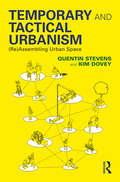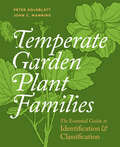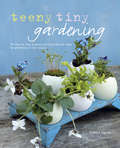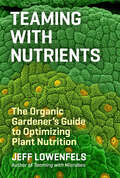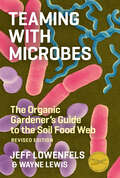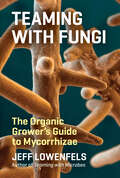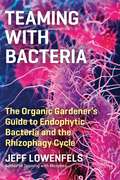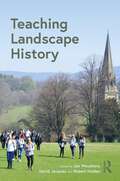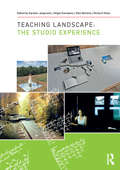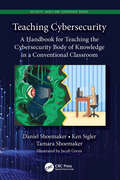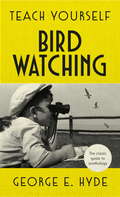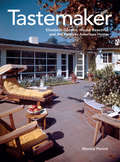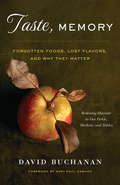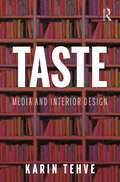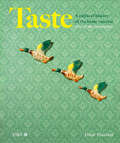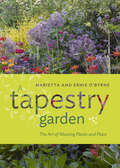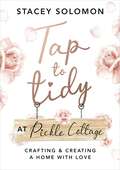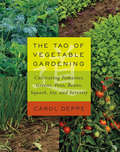- Table View
- List View
Temporary and Tactical Urbanism: (Re)Assembling Urban Space
by Quentin Stevens Kim DoveyTemporary and Tactical Urbanism examines a key set of urban design strategies that have emerged in the twenty-first century. Such projects range from guerrilla gardens and bike lanes to more formalised temporary beaches and swimming pools, parklets, pop-up plazas and buildings and container towns. These practices enable diverse forms of economic, social and artistic life that are usually repressed by the fixities of urban form and its management. This book takes a thematic approach to explore what the scope of this practice is, and understand why it has risen to prominence, how it works, who is involved, and what its implications are for the future of city design and planning. It critically examines the material, social, economic and political complexities that surround and enable these small, ephemeral urban interventions. It identifies their short-term and long-term implications for urban intensity, diversity, creativity and adaptability. The book's insights into temporary and tactical urbanism have particular relevance in the context of the COVID-19 pandemic, which has highlighted both the need and the possibility of quickly transforming urban spaces worldwide. They also reveal significant lessons for the long-term planning and design of buildings, landscapes and cities.
Temperate Garden Plant Families: The Essential Guide to Identification and Classification
by Peter Goldblatt John C. ManningThe first comprehensive identification guide to include new classifications based on DNA analysis, this resource helps readers identify the 140 most important temperate plant families.
Teeny Tiny Gardening: 35 step-by-step projects and inspirational ideas for gardening in tiny spaces
by Emma HardyTeeny Tiny Gardening is horticulture on the smallest of scales. No matter how tiny your space - indoor or outdoor, garden, yard, balcony or even just a windowsill or tabletop - here you will find original, fun and inspiring ideas. The 35 projects range from an elegant fern terrarium and a scented spring bulb basket to colourful woven bags and hessian sacks filled with cheerful summer blooms. There are edible gardens, including fruit bushes planted in catering-sized kitchen pans and a vertical garden of herbs grown on a wooden stepladder. You will find lots of ideas for using recycled and salvaged containers, such as a metal bathtub filled with vegetable plants, metal food tins used for an indoor garden of wildflowers and a stack of wooden drawers filled with trailing plants. And at the teeniest end of the scale, there are even miniature tabletop gardens created in eggshells and bottle tops! Children can learn basic gardening skills, too, by following the step-by-step photos to make their own magical fairy garden or a mysterious dinosaur den. Whether you are looking for ideas for all-year foliage or for a summer display of flowers, wanting to grow your own veggies and herbs, or needing to revamp your balcony, Teeny Tiny Gardening will provide you with all the inspiration and practical knowledge you need.
Teddy Bear (UEB Uncontracted)
by Rnib BookshareThis page shows a teddy bear. There is a locator dot shown, which will be at the top left of the page when the image is the right way up. He is sitting facing you in the middle of the page with his head at the top. He has two curved ears on top of his head and his friendly face with two small eyes, a large round nose and a smiley mouth. Below this is his body; he is holding his arms out on either side. His chunky legs are at the bottom. As found on all good teddy bears, he has pads on paws.
Teddy Bear (UEB Contracted)
by Rnib BookshareThis page shows a teddy bear. There is a locator dot shown, which will be at the top left of the page when the image is the right way up. He is sitting facing you in the middle of the page with his head at the top. He has two curved ears on top of his head and his friendly face with two small eyes, a large round nose and a smiley mouth. Below this is his body; he is holding his arms out on either side. His chunky legs are at the bottom. As found on all good teddy bears, he has pads on paws.
Teddy Bear (Large Print)
by Rnib BookshareThis page shows a teddy bear. There is a locator dot shown, which will be at the top left of the page when the image is the right way up. He is sitting facing you in the middle of the page with his head at the top. He has two curved ears on top of his head and his friendly face with two small eyes, a large round nose and a smiley mouth. Below this is his body; he is holding his arms out on either side. His chunky legs are at the bottom. As found on all good teddy bears, he has pads on paws.
Teaming with Nutrients: The Organic Gardener's Guide to Optimizing Plant Nutrition
by Jeff LowenfelsTeaming with Nutrients will make you a better informed, more successful, more environmentally responsible gardener and will give you a new appreciation for the plants you grow.
Teaming with Microbes: The Organic Gardener's Guide to the Soil Food Web, Revised Edition
by Jeff Lowenfels Wayne LewisThere is an alternative to the vicious circle of chemical fertilizers: to garden in a way that strengthens, rather than destroys, the soil food web—the complex world of soil-dwelling organisms whose interactions create a nurturing environment for plants.
Teaming with Fungi: The Organic Grower's Guide to Mycorrhizae
by Jeff LowenfelsTeaming with Fungi is the first book to accessibly explain the essential symbiotic relationship between soil-dwelling mycorrhizal fungi and plants.
Teaming with Bacteria: The Organic Gardener's Guide to Endophytic Bacteria and the Rhizophagy Cycle
by Jeff LowenfelsJust as Teaming with Microbes introduced readers to the soil food web, Teaming with Bacteria will introduce the latest research on endophytic bacteria and rhizophagy—discoveries that have profound implications for the practices of home gardeners and small-scale growers.
Teaching Landscape History
by Jan Woudstra David JacquesLandscape history is changing in content and style to address the issues of today. Experienced teachers and authors on the history of gardens and landscapes come together in this new volume to share ideas on the future of teaching history in departments of landscape architecture, archaeology, geography and allied subjects. Design history remains important, but this volume brings to the fore the increasing importance of environmental history, economic history, landscape history, cultural landscapes, environmental justice and decolonisation, ideas of sustainability and climate change amelioration, which may all be useful in serving the needs of a widening range of students in an increasingly complex world. The main themes include: what history should we narrate in the education of landscape architects? how can we recognise counter-narratives and our own bias? how should we engage the students in the history of their chosen profession? how can designers and researchers be persuaded of the relevance of history teaching to theory and practice? and what resources do we need to develop teaching of landscape histories? This book will be of interest to anyone teaching courses on landscape architecture, urban design, horticulture, garden design, architectural history, cultural geography and more.
Teaching Landscape History
Landscape history is changing in content and style to address the issues of today. Experienced teachers and authors on the history of gardens and landscapes come together in this new volume to share ideas on the future of teaching history in departments of landscape architecture, archaeology, geography and allied subjects. Design history remains important, but this volume brings to the fore the increasing importance of environmental history, economic history, landscape history, cultural landscapes, environmental justice and decolonisation, ideas of sustainability and climate change amelioration, which may all be useful in serving the needs of a widening range of students in an increasingly complex world. The main themes include: what history should we narrate in the education of landscape architects? how can we recognise counter-narratives and our own bias? how should we engage the students in the history of their chosen profession? how can designers and researchers be persuaded of the relevance of history teaching to theory and practice? and what resources do we need to develop teaching of landscape histories? This book will be of interest to anyone teaching courses on landscape architecture, urban design, horticulture, garden design, architectural history, cultural geography and more.
Teaching Landscape: The Studio Experience
by Karsten Jorgensen Nilgul Karadeniz Elke Mertens Richard StilesTeaching Landscape: The Studio Experience gathers a range of expert contributions from across the world to collect best-practice examples of teaching landscape architecture studios. This is the companion volume to The Routledge Handbook of Teaching Landscape in the two-part set initiated by the European Council of Landscape Architecture Schools (ECLAS). Design and planning studio as a form of teaching lies at the core of landscape architecture education. They can simulate a professional situation and promote the development of creative solutions based on gaining an understanding of a specific project site or planning area; address existing challenges in urban and rural landscapes; and often involve interaction with real stakeholders, such as municipality representatives, residents or activist groups. In this way, studio-based planning and design teaching brings students closer to everyday practice, helping to prepare them to create real-world, problem-solving designs. This book provides fully illustrated examples of studios from over twenty different schools of landscape architecture worldwide. With over 250 full colour images, it is an essential resource for instructors and academics across the landscape discipline, for the continuously evolving process of discussing and generating improved teaching modes in landscape architecture.
Teaching Cybersecurity: A Handbook for Teaching the Cybersecurity Body of Knowledge in a Conventional Classroom (Security, Audit and Leadership Series)
by Daniel Shoemaker Ken Sigler Tamara ShoemakerLet’s be realistic here. Ordinary K-12 educators don’t know what "cybersecurity" is and could probably care less about incorporating it into their lesson plans. Yet, teaching cybersecurity is a critical national priority. So, this book aims to cut through the usual roadblocks of confusing technical jargon and industry stovepipes and give you, the classroom teacher, a unified understanding of what must be taught. That advice is based on a single authoritative definition of the field. In 2017, the three societies that write the standards for computing, software engineering, and information systems came together to define a single model of the field of cybersecurity. It is based on eight building blocks. That definition is presented here. However, we also understand that secondary school teachers are not experts in arcane subjects like software, component, human, or societal security. Therefore, this book explains cybersecurity through a simple story rather than diving into execution details. Tom, a high school teacher, and Lucy, a middle school teacher, are tasked by their district to develop a cybersecurity course for students in their respective schools. They are aided in this by "the Doc," an odd fellow but an expert in the field. Together they work their way through the content of each topic area, helping each other to understand what the student at each level in the educational process has to learn. The explanations are simple, easy to understand, and geared toward the teaching aspect rather than the actual performance of cybersecurity work. Each chapter is a self-contained explanation of the cybersecurity content in that area geared to teaching both middle and high school audiences. The eight component areas are standalone in that they can be taught separately. But the real value lies in the comprehensive but easy-to-understand picture that the reader will get of a complicated field.
Teaching Cybersecurity: A Handbook for Teaching the Cybersecurity Body of Knowledge in a Conventional Classroom (Security, Audit and Leadership Series)
by Daniel Shoemaker Ken Sigler Tamara ShoemakerLet’s be realistic here. Ordinary K-12 educators don’t know what "cybersecurity" is and could probably care less about incorporating it into their lesson plans. Yet, teaching cybersecurity is a critical national priority. So, this book aims to cut through the usual roadblocks of confusing technical jargon and industry stovepipes and give you, the classroom teacher, a unified understanding of what must be taught. That advice is based on a single authoritative definition of the field. In 2017, the three societies that write the standards for computing, software engineering, and information systems came together to define a single model of the field of cybersecurity. It is based on eight building blocks. That definition is presented here. However, we also understand that secondary school teachers are not experts in arcane subjects like software, component, human, or societal security. Therefore, this book explains cybersecurity through a simple story rather than diving into execution details. Tom, a high school teacher, and Lucy, a middle school teacher, are tasked by their district to develop a cybersecurity course for students in their respective schools. They are aided in this by "the Doc," an odd fellow but an expert in the field. Together they work their way through the content of each topic area, helping each other to understand what the student at each level in the educational process has to learn. The explanations are simple, easy to understand, and geared toward the teaching aspect rather than the actual performance of cybersecurity work. Each chapter is a self-contained explanation of the cybersecurity content in that area geared to teaching both middle and high school audiences. The eight component areas are standalone in that they can be taught separately. But the real value lies in the comprehensive but easy-to-understand picture that the reader will get of a complicated field.
Teach Yourself Bird Watching: The classic guide to ornithology
by GE HydeWith a few sorry exceptions, it's heartening to think that the gardener or bird-spotter of the 1950s or 60s would immediately recognise most of the songs that sing out over English gardens today. For the amateur ornithologist of the twenty first century, Teach Yourself Bird Watching will be as much of a delight now as it ever was - a beautifully written, precise guide to identifying, protecting and encouraging birdlife in your garden and beyond.Since 1938, millions of people have learned to do the things they love with Teach Yourself. Welcome to the how-to guides that changed the modern world.
Tastemaker: Elizabeth Gordon, House Beautiful, and the Postwar American Home
by Monica PenickA riveting and superbly illustrated account of the enigmatic House Beautiful editor’s profound influence on mid-century American taste From 1941 to 1964, House Beautiful magazine’s crusading editor-in-chief Elizabeth Gordon introduced and promoted her vision of “good design” and “better living” to an extensive middle-class American readership. Her innovative magazine-sponsored initiatives, including House Beautiful’s Pace Setter House Program and the Climate Control Project, popularized a “livable” and decidedly American version of postwar modern architecture. Gordon’s devotion to what she called the American Style attracted the attention of Frank Lloyd Wright, who became her ally and collaborator. Gordon’s editorial programs reshaped ideas about American living and, by extension, what consumers bought, what designers made, and what manufacturers brought to market. This incisive assessment of Gordon’s influence as an editor, critic, and arbiter of domestic taste reflects more broadly on the cultures of consumption and identity in postwar America. Nearly 200 images are featured, including work by Ezra Stoller, Maynard Parker, and Julius Shulman. This important book champions an often-neglected source—the consumer magazine—as a key tool for deepening our understanding of mid-century architecture and design.
Taste, Memory: Forgotten Foods, Lost Flavors, and Why They Matter
by David Buchanan Gary Paul NabhanTaste, Memory traces the experiences of modern-day explorers who rediscover culturally rich forgotten foods and return them to our tables for all to experience and savor. In Taste, Memory author David Buchanan explores questions fundamental to the future of food and farming. How can we strike a balance between preserving the past, maintaining valuable agricultural and culinary traditions, and looking ahead to breed new plants? What place does a cantankerous old pear or too-delicate strawberry deserve in our gardens, farms, and markets? To what extent should growers value efficiency and uniformity over matters of taste, ecology, or regional identity? While living in Washington State in the early nineties, Buchanan learned about the heritage food movement and began growing fruit trees, grains, and vegetables. After moving home to New England, however, he left behind his plant collection and for several years stopped gardening. In 2005, inspired by the revival of interest in regional food and culinary traditions, Buchanan borrowed a few rows of growing space at a farm near his home in Portland, Maine, where he resumed collecting. By 2012 he had expanded to two acres, started a nursery and small business, and discovered creative ways to preserve rare foods. In Taste, Memory Buchanan shares stories of slightly obsessive urban gardeners, preservationists, environmentalists, farmers, and passionate cooks, and weaves anecdotes of his personal journey with profiles of leaders in the movement to defend agricultural biodiversity. Taste, Memory begins and ends with a simple premise: that a healthy food system depends on matching diverse plants and animals to the demands of land and climate. In this sense of place lies the true meaning of local food.
Taste: Media and Interior Design
by Karin TehveThis book traces and explores the evolution of taste from a design perspective: what it is, how it works, and what it does. Karin Tehve examines taste primarily through its recursive relationship to media. This ongoing process changes the relationship between designers and the public, and our understanding of the relationship of individuals to their social contexts. Through an analysis of taste, design is understood to be an active constituent of social life, not as autonomous from it. This book reclaims a term long dismissed from interior design and unveils taste’s role as a powerful social and political agent within systems of aesthetics, affecting both its producers and consumers. Each chapter discusses a taste concept or definition, analyzes its reciprocal relationship with media, and explores its implications for interior design. Illustrated with 70 images, taste’s relationship to media is viewed through a variety of different lenses, including books, photography, magazines, internet, social media and algorithms. Written primarily for students and scholars of interior design and related design fields, this book will be a helpful resource for all those interested in the question of taste, and is an invitation to produce and consume all media critically.
Taste: Media and Interior Design
by Karin TehveThis book traces and explores the evolution of taste from a design perspective: what it is, how it works, and what it does. Karin Tehve examines taste primarily through its recursive relationship to media. This ongoing process changes the relationship between designers and the public, and our understanding of the relationship of individuals to their social contexts. Through an analysis of taste, design is understood to be an active constituent of social life, not as autonomous from it. This book reclaims a term long dismissed from interior design and unveils taste’s role as a powerful social and political agent within systems of aesthetics, affecting both its producers and consumers. Each chapter discusses a taste concept or definition, analyzes its reciprocal relationship with media, and explores its implications for interior design. Illustrated with 70 images, taste’s relationship to media is viewed through a variety of different lenses, including books, photography, magazines, internet, social media and algorithms. Written primarily for students and scholars of interior design and related design fields, this book will be a helpful resource for all those interested in the question of taste, and is an invitation to produce and consume all media critically.
Taste: A cultural history of the home interior
by Drew PlunkettDemocratic in intention and approach, the book will argue that the home interior, as independently created by the ‘amateur’ householder, offers a continuous informal critique of shifting architectural styles (most notably with the advent of Modernism) and the design mainstream. Indeed, it will suggest that the popular increasingly exerts an influence on the professional. Underpinned by academic rigour, but not in thrall to it, above all this book is an engaging attempt to identify the cultural drivers of aesthetic change in the home, extrapolating the wider influence of ‘taste’ to a broad audience – both professional and ‘trade’. In so doing, it will explore enthralling territory – money, class, power and influence. Illustrated with contemporary drawings and cartoons as well as photos, the book will not only be an absorbing read, but an enticing and attractive object in itself.
Taste: A cultural history of the home interior
by Drew PlunkettDemocratic in intention and approach, the book will argue that the home interior, as independently created by the ‘amateur’ householder, offers a continuous informal critique of shifting architectural styles (most notably with the advent of Modernism) and the design mainstream. Indeed, it will suggest that the popular increasingly exerts an influence on the professional. Underpinned by academic rigour, but not in thrall to it, above all this book is an engaging attempt to identify the cultural drivers of aesthetic change in the home, extrapolating the wider influence of ‘taste’ to a broad audience – both professional and ‘trade’. In so doing, it will explore enthralling territory – money, class, power and influence. Illustrated with contemporary drawings and cartoons as well as photos, the book will not only be an absorbing read, but an enticing and attractive object in itself.
A Tapestry Garden: The Art of Weaving Plants and Place
by Ernie O'Byrne Marietta O'ByrneEqual parts inspirational and practical, A Tapestry Garden will help you weave your own incredible garden.
Tap to Tidy at Pickle Cottage: Crafting & Creating a Home with Love
by Stacey Solomon'To say we are excited for the release of this book is a massive understatement' Closer'Fun, practical and friendly - like Solomon herself' Guardian'This book is for you to use as a guide, as inspiration, or even just to read without any pressure to do anything at all! Grab a cuppa and dip in and out of it at leisure. I want you to know that you really do have the skill to do anything you want - don't let anyone tell you otherwise. Having your own home is something we all dream about. I hope this book will give you the confidence to pick up a drill, paint brush, hammer or a hack saw and make your space the home of your dreams.' Stace xxDiscover Stacey's Tap to Tidy DIY Method - with steps on how to get started. Each chapter takes readers round a room in Stacey's dream home, and how she transformed each room herself.Each chapter includes:· Hero projects: Big renovation or organisational projects· Quick fixes: Small jobs to spruce up a room· Make-ups: My transformative craft projects and accessories· Little things I love: Power tools, amazing DIY products, my favourite accessories...· Tips: Stacey's tips to make your projects run smoothly· Expert help: tips on when you need to call in the experts
The Tao of Vegetable Gardening: Cultivating Tomatoes, Greens, Peas, Beans, Squash, Joy, and Serenity
by Carol DeppeThe Tao of Vegetable Gardening explores the practical methods as well as the deeper essence of gardening. In her latest book, groundbreaking garden writer Carol Deppe (The Resilient Gardener, Breed Your Own Vegetable Varieties) focuses on some of the most popular home garden vegetables—tomatoes, green beans, peas, and leafy greens—and through them illustrates the key principles and practices that gardeners need to know to successfully plant and grow just about any food crop. Deppe’s work has long been inspired and informed by the philosophy and wisdom of Tao Te Ching, the 2,500-year-old work attributed to Chinese sage Lao Tzu and the most translated book in the world after the Bible. The Tao of Vegetable Gardening is organized into chapters that echo fundamental Taoist concepts: Balance, Flexibility, Honoring the Essential Nature (your own and that of your plants), Effortless Effort, Non-Doing, and even Non-Knowing. Yet the book also offers a wealth of specific and valuable garden advice on topics as diverse as: • The Eat-All Greens Garden, a labor- and space-efficient way to provide all the greens a family can eat, freeze, and dry—all on a tiny piece of land suitable for small-scale and urban gardeners. • The growing problem of late blight and the future of heirloom tomatoes—and what gardeners can do to avoid problems, and even create new resistant varieties. • Establishing a Do-It-Yourself Seed Bank, including information on preparing seeds for long-term storage and how to “dehybridize” hybrids. • Twenty-four good places to not plant a tree, and thirty-seven good reasons for not planting various vegetables. Designed for gardeners of all levels, from beginners to experienced growers, The Tao of Vegetable Gardening provides a unique frame of reference: a window to the world of nature, in the garden and in ourselves.
